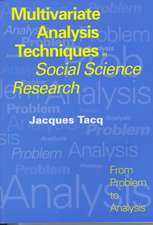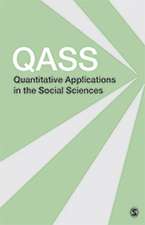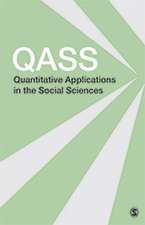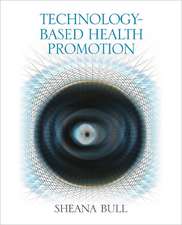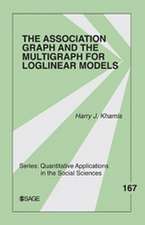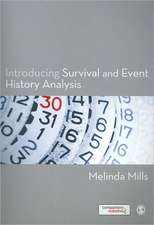Applied Regression Analysis and Generalized Linear Models
Autor John Foxen Limba Engleză Hardback – 25 mai 2015
Combining a modern, data-analytic perspective with a focus on applications in the social sciences, the Third Edition of Applied Regression Analysis and Generalized Linear Models provides in-depth coverage of regression analysis, generalized linear models, and closely related methods, such as bootstrapping and missing data. Updated throughout, this Third Edition includes new chapters on mixed-effects models for hierarchical and longitudinal data. Although the text is largely accessible to readers with a modest background in statistics and mathematics, author John Fox also presents more advanced material in optional sections and chapters throughout the book.
Preț: 1108.53 lei
Preț vechi: 1518.53 lei
-27% Nou
Puncte Express: 1663
Preț estimativ în valută:
212.11€ • 222.09$ • 175.94£
212.11€ • 222.09$ • 175.94£
Carte tipărită la comandă
Livrare economică 09-23 aprilie
Preluare comenzi: 021 569.72.76
Specificații
ISBN-13: 9781452205663
ISBN-10: 1452205663
Pagini: 816
Dimensiuni: 178 x 254 x 38 mm
Greutate: 1.41 kg
Ediția:Third Edition
Editura: SAGE Publications
Colecția Sage Publications, Inc
Locul publicării:Thousand Oaks, United States
ISBN-10: 1452205663
Pagini: 816
Dimensiuni: 178 x 254 x 38 mm
Greutate: 1.41 kg
Ediția:Third Edition
Editura: SAGE Publications
Colecția Sage Publications, Inc
Locul publicării:Thousand Oaks, United States
Recenzii
The strength of this text is the unified presentation of several regression topics that provides the student with a global perspective on regression analysis. The student is well served with this unified approach as it facilitates deeper research on any one topic with more advanced texts.
This text is a one-stop shop for me for my first year stats sequence for students in our program. Those wanting the technical detail will be satisfied; those wanting an excellent explanation of these methods using real-world examples and approachable language will also be satisfied.
I have enjoyed using previous editions of this text and look forward to using this edition. It covers all key topics, and quite a few advanced ones, in one well-written text.
PRAISE FOR THE PREVIOUS EDITIONS
In summary, this is an excellent text on regression applications and methods, written with authority, lucidity, and eloquence. The second edition provides substantive and topical updates, and makes the book suitable for courses designed to emphasize both the classical and the modern aspects of regression.
PRAISE FOR THE PREVIOUS EDITIONS
Even though the book is written with social scientists as the target audience, the depth of material and how it is conveyed give it far broader appeal. Indeed, I recommend it as a useful learning text and resource for researchers and students in any field that applies regression or linear models (that is, most everyone), including courses for undergraduate statistics majors…. The author is to be commended for giving us this book, which I trust will find a wide and enduring readership.
PRAISE FOR THE PREVIOUS EDITIONS
[T]his wonderfully comprehensive book focuses on regression analysis and linear models… We enthusiastically recommend this book—having used it in class, we know that it is thorough and well-liked by students.
This text is a one-stop shop for me for my first year stats sequence for students in our program. Those wanting the technical detail will be satisfied; those wanting an excellent explanation of these methods using real-world examples and approachable language will also be satisfied.
I have enjoyed using previous editions of this text and look forward to using this edition. It covers all key topics, and quite a few advanced ones, in one well-written text.
PRAISE FOR THE PREVIOUS EDITIONS
In summary, this is an excellent text on regression applications and methods, written with authority, lucidity, and eloquence. The second edition provides substantive and topical updates, and makes the book suitable for courses designed to emphasize both the classical and the modern aspects of regression.
PRAISE FOR THE PREVIOUS EDITIONS
Even though the book is written with social scientists as the target audience, the depth of material and how it is conveyed give it far broader appeal. Indeed, I recommend it as a useful learning text and resource for researchers and students in any field that applies regression or linear models (that is, most everyone), including courses for undergraduate statistics majors…. The author is to be commended for giving us this book, which I trust will find a wide and enduring readership.
PRAISE FOR THE PREVIOUS EDITIONS
[T]his wonderfully comprehensive book focuses on regression analysis and linear models… We enthusiastically recommend this book—having used it in class, we know that it is thorough and well-liked by students.
Cuprins
Preface
About the Author
1. Statistical Models and Social Science
1.1 Statistical Models and Social Reality
1.2 Observation and Experiment
1.3 Populations and Samples
I. DATA CRAFT
2. What Is Regression Analysis?
2.1 Preliminaries
2.2 Naive Nonparametric Regression
2.3 Local Averaging
3. Examining Data
3.1 Univariate Displays
3.2 Plotting Bivariate Data
3.3 Plotting Multivariate Data
4. Transforming Data
4.1 The Family of Powers and Roots
4.2 Transforming Skewness
4.3 Transforming Nonlinearity
4.4 Transforming Nonconstant Spread
4.5 Transforming Proportions
4.6 Estimating Transformations as Parameters*
II. LINEAR MODELS AND LEAST SQUARES
5. Linear Least-Squares Regression
5.1 Simple Regression
5.2 Multiple Regression
6. Statistical Inference for Regression
6.1 Simple Regression
6.2 Multiple Regression
6.3 Empirical Versus Structural Relations
6.4 Measurement Error in Explanatory Variables*
7. Dummy-Variable Regression
7.1 A Dichotomous Factor
7.2 Polytomous Factors
7.3 Modeling Interactions
8. Analysis of Variance
8.1 One-Way Analysis of Variance
8.2 Two-Way Analysis of Variance
8.3 Higher-Way Analysis of Variance
8.4 Analysis of Covariance
8.5 Linear Contrasts of Means
9. Statistical Theory for Linear Models*
9.1 Linear Models in Matrix Form
9.2 Least-Squares Fit
9.3 Properties of the Least-Squares Estimator
9.4 Statistical Inference for Linear Models
9.5 Multivariate Linear Models
9.6 Random Regressors
9.7 Specification Error
9.8 Instrumental Variables and Two-Stage Least Squares
10. The Vector Geometry of Linear Models*
10.1 Simple Regression
10.2 Multiple Regression
10.3 Estimating the Error Variance
10.4 Analysis-of-Variance Models
III. LINEAR-MODEL DIAGNOSTICS
11. Unusual and Influential Data
11.1 Outliers, Leverage, and Influence
11.2 Assessing Leverage: Hat-Values
11.3 Detecting Outliers: Studentized Residuals
11.4 Measuring Influence
11.5 Numerical Cutoffs for Diagnostic Statistics
11.6 Joint Influence
11.7 Should Unusual Data Be Discarded?
11.8 Some Statistical Details*
12. Non-Normality, Nonconstant Error Variance, Nonlinearity
12.1 Non-Normally Distributed Errors
12.2 Nonconstant Error Variance
12.3 Nonlinearity
12.4 Discrete Data
12.5 Maximum-Likelihood Methods*
12.6 Structural Dimension
13. Collinearity and Its Purported Remedies
13.1 Detecting Collinearity
13.2 Coping With Collinearity: No Quick Fix
IV. GENERALIZED LINEAR MODELS
14. Logit and Probit Models for Categorical Response Variables
14.1 Models for Dichotomous Data
14.2 Models for Polytomous Data
14.3 Discrete Explanatory Variables and Contingency Tables
15. Generalized Linear Models
15.1 The Structure of Generalized Linear Models
15.2 Generalized Linear Models for Counts
15.3 Statistical Theory for Generalized Linear Models*
15.4 Diagnostics for Generalized Linear Models
15.5 Analyzing Data From Complex Sample Surveys
V. EXTENDING LINEAR AND GENERALIZED LINEAR MODELS
16. Time-Series Regression and Generalized Leasr Squares*
16.1 Generalized Least-Squares Estimation
16.2 Serially Correlated Errors
16.3 GLS Estimation With Autocorrelated Errors
16.4 Correcting OLS Inference for Autocorrelated Errors
16.5 Diagnosing Serially Correlated Errors
16.6 Concluding Remarks
17. Nonlinear Regression
17.1 Polynomial Regression
17.2 Piece-wise Polynomials and Regression Splines
17.3 Transformable Nonlinearity
17.4 Nonlinear Least Squares*
18. Nonparametric Regression
18.1 Nonparametric Simple Regression: Scatterplot Smoothing
18.2 Nonparametric Multiple Regression
18.3 Generalized Nonparametric Regression
19. Robust Regression*
19.1 M Estimation
19.2 Bounded-Influence Regression
19.3 Quantile Regression
19.4 Robust Estimation of Generalized Linear Models
19.5 Concluding Remarks
20. Missing Data in Regression Models
20.1 Missing Data Basics
20.2 Traditional Approaches to Missing Data
20.3 Maximum-Likelihood Estimation for Data Missing at Random*
20.4 Bayesian Multiple Imputation
20.5 Selection Bias and Censoring
21. Bootstrapping Regression Models
21.1 Bootstrapping Basics
21.2 Bootstrap Confidence Intervals
21.3 Bootstrapping Regression Models
21.4 Bootstrap Hypothesis Tests*
21.5 Bootstrapping Complex Sampling Designs
21.6 Concluding Remarks
22. Model Selection, Averaging, and Validation
22.1 Model Selection
22.2 Model Averaging*
22.3 Model Validation
VI. MIXED-EFFECT MODELS
23. Linear Mixed-Effects Models for Hierarchical and Longitudinal Data
23.1 Hierarchical and Longitudinal Data
23.2 The Linear Mixed-Effects Model
23.3 Modeling Hierarchical Data
23.4 Modeling Longitudinal Data
23.5 Wald Tests for Fixed Effects
23.6 Likelihood-Ratio Tests of Variance and Covariance Components
23.7 Centering Explanatory Variables, Contextual Effects, and Fixed-Effects Models
23.8 BLUPs
23.9 Statistical Details*
24. Generalized Linear and Nonlinear Mixed-Effects Models
24.1 Generalized Linear Mixed Models
24.2 Nonlinear Mixed Models
Appendix A
References
Author Index
Subject Index
Data Set Index
About the Author
1. Statistical Models and Social Science
1.1 Statistical Models and Social Reality
1.2 Observation and Experiment
1.3 Populations and Samples
I. DATA CRAFT
2. What Is Regression Analysis?
2.1 Preliminaries
2.2 Naive Nonparametric Regression
2.3 Local Averaging
3. Examining Data
3.1 Univariate Displays
3.2 Plotting Bivariate Data
3.3 Plotting Multivariate Data
4. Transforming Data
4.1 The Family of Powers and Roots
4.2 Transforming Skewness
4.3 Transforming Nonlinearity
4.4 Transforming Nonconstant Spread
4.5 Transforming Proportions
4.6 Estimating Transformations as Parameters*
II. LINEAR MODELS AND LEAST SQUARES
5. Linear Least-Squares Regression
5.1 Simple Regression
5.2 Multiple Regression
6. Statistical Inference for Regression
6.1 Simple Regression
6.2 Multiple Regression
6.3 Empirical Versus Structural Relations
6.4 Measurement Error in Explanatory Variables*
7. Dummy-Variable Regression
7.1 A Dichotomous Factor
7.2 Polytomous Factors
7.3 Modeling Interactions
8. Analysis of Variance
8.1 One-Way Analysis of Variance
8.2 Two-Way Analysis of Variance
8.3 Higher-Way Analysis of Variance
8.4 Analysis of Covariance
8.5 Linear Contrasts of Means
9. Statistical Theory for Linear Models*
9.1 Linear Models in Matrix Form
9.2 Least-Squares Fit
9.3 Properties of the Least-Squares Estimator
9.4 Statistical Inference for Linear Models
9.5 Multivariate Linear Models
9.6 Random Regressors
9.7 Specification Error
9.8 Instrumental Variables and Two-Stage Least Squares
10. The Vector Geometry of Linear Models*
10.1 Simple Regression
10.2 Multiple Regression
10.3 Estimating the Error Variance
10.4 Analysis-of-Variance Models
III. LINEAR-MODEL DIAGNOSTICS
11. Unusual and Influential Data
11.1 Outliers, Leverage, and Influence
11.2 Assessing Leverage: Hat-Values
11.3 Detecting Outliers: Studentized Residuals
11.4 Measuring Influence
11.5 Numerical Cutoffs for Diagnostic Statistics
11.6 Joint Influence
11.7 Should Unusual Data Be Discarded?
11.8 Some Statistical Details*
12. Non-Normality, Nonconstant Error Variance, Nonlinearity
12.1 Non-Normally Distributed Errors
12.2 Nonconstant Error Variance
12.3 Nonlinearity
12.4 Discrete Data
12.5 Maximum-Likelihood Methods*
12.6 Structural Dimension
13. Collinearity and Its Purported Remedies
13.1 Detecting Collinearity
13.2 Coping With Collinearity: No Quick Fix
IV. GENERALIZED LINEAR MODELS
14. Logit and Probit Models for Categorical Response Variables
14.1 Models for Dichotomous Data
14.2 Models for Polytomous Data
14.3 Discrete Explanatory Variables and Contingency Tables
15. Generalized Linear Models
15.1 The Structure of Generalized Linear Models
15.2 Generalized Linear Models for Counts
15.3 Statistical Theory for Generalized Linear Models*
15.4 Diagnostics for Generalized Linear Models
15.5 Analyzing Data From Complex Sample Surveys
V. EXTENDING LINEAR AND GENERALIZED LINEAR MODELS
16. Time-Series Regression and Generalized Leasr Squares*
16.1 Generalized Least-Squares Estimation
16.2 Serially Correlated Errors
16.3 GLS Estimation With Autocorrelated Errors
16.4 Correcting OLS Inference for Autocorrelated Errors
16.5 Diagnosing Serially Correlated Errors
16.6 Concluding Remarks
17. Nonlinear Regression
17.1 Polynomial Regression
17.2 Piece-wise Polynomials and Regression Splines
17.3 Transformable Nonlinearity
17.4 Nonlinear Least Squares*
18. Nonparametric Regression
18.1 Nonparametric Simple Regression: Scatterplot Smoothing
18.2 Nonparametric Multiple Regression
18.3 Generalized Nonparametric Regression
19. Robust Regression*
19.1 M Estimation
19.2 Bounded-Influence Regression
19.3 Quantile Regression
19.4 Robust Estimation of Generalized Linear Models
19.5 Concluding Remarks
20. Missing Data in Regression Models
20.1 Missing Data Basics
20.2 Traditional Approaches to Missing Data
20.3 Maximum-Likelihood Estimation for Data Missing at Random*
20.4 Bayesian Multiple Imputation
20.5 Selection Bias and Censoring
21. Bootstrapping Regression Models
21.1 Bootstrapping Basics
21.2 Bootstrap Confidence Intervals
21.3 Bootstrapping Regression Models
21.4 Bootstrap Hypothesis Tests*
21.5 Bootstrapping Complex Sampling Designs
21.6 Concluding Remarks
22. Model Selection, Averaging, and Validation
22.1 Model Selection
22.2 Model Averaging*
22.3 Model Validation
VI. MIXED-EFFECT MODELS
23. Linear Mixed-Effects Models for Hierarchical and Longitudinal Data
23.1 Hierarchical and Longitudinal Data
23.2 The Linear Mixed-Effects Model
23.3 Modeling Hierarchical Data
23.4 Modeling Longitudinal Data
23.5 Wald Tests for Fixed Effects
23.6 Likelihood-Ratio Tests of Variance and Covariance Components
23.7 Centering Explanatory Variables, Contextual Effects, and Fixed-Effects Models
23.8 BLUPs
23.9 Statistical Details*
24. Generalized Linear and Nonlinear Mixed-Effects Models
24.1 Generalized Linear Mixed Models
24.2 Nonlinear Mixed Models
Appendix A
References
Author Index
Subject Index
Data Set Index
Notă biografică
Descriere
Providing a modern treatment of regression analysis, linear models and closely related methods, this book introduces students to one of the most useful and widely used statistical tools for social research.







